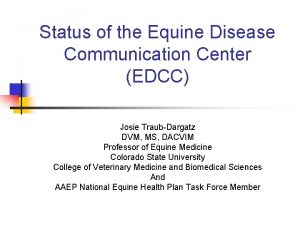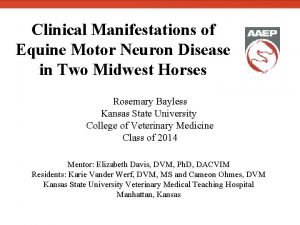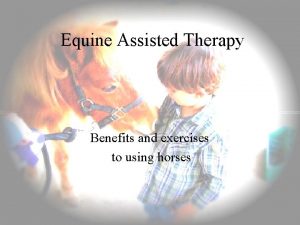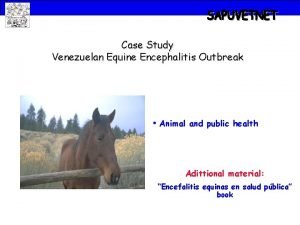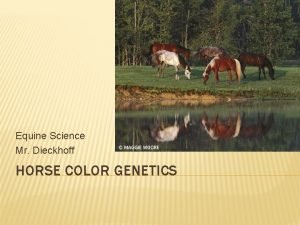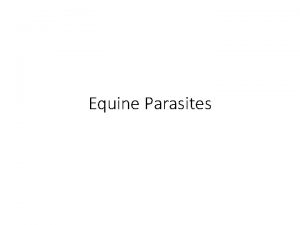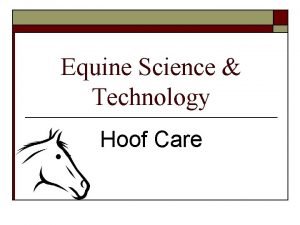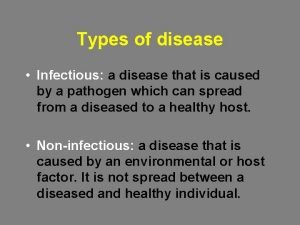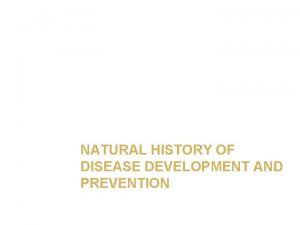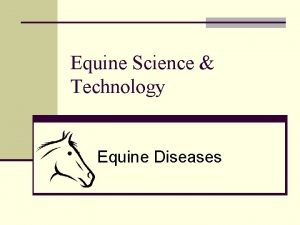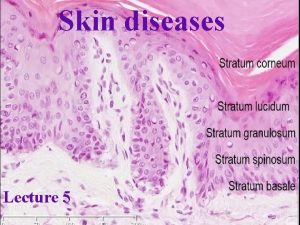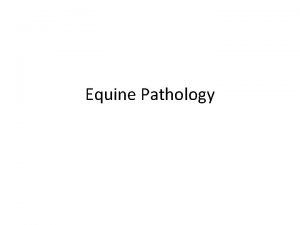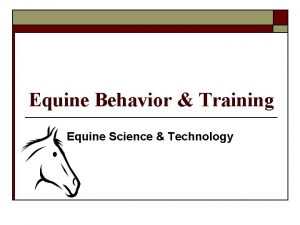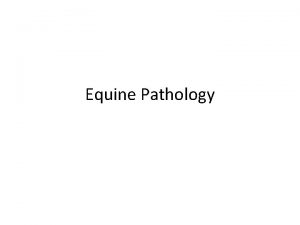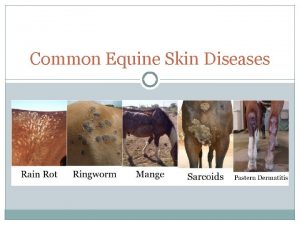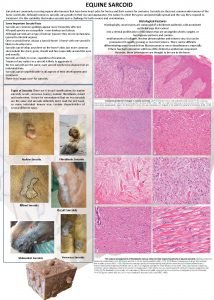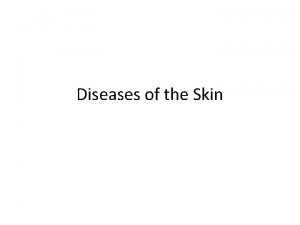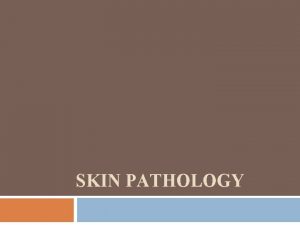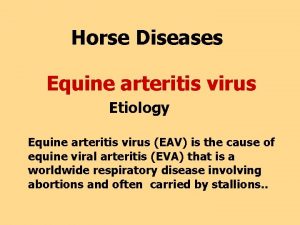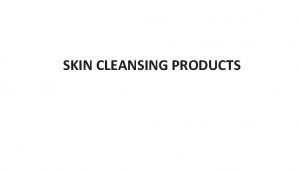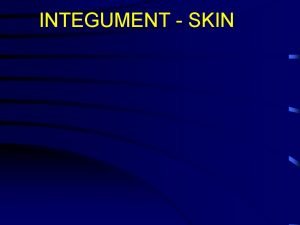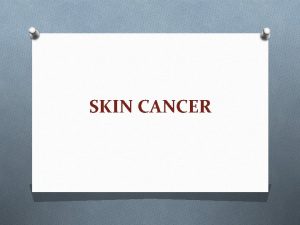Equine Skin Diseases What is a Disease Definition
































- Slides: 32

Equine Skin Diseases

What is a Disease? �Definition: a malfunction of a structure or job of a structure that is caused by an organism that creates signs and symptoms of its living state in a human, animal or plant.

What are the Causes of Diseases? �Causes: Environmental stress Direct contact � Transferred by touch Indirect contact � Transferred through the air Example: Cough Poor Nutrition Microorganisms Parasites

Common Equine Skin Diseases Mange Ringworm Rain Rot Sarcoids Pastern Dermatitis

Rain Rot “Rain Scald” � One of the most common skin diseases � Not life threatening or painful to the horse Exception is the scab removal � What is it? : Scabs form underneath the hair The hair will mat and fall out Causes the skin to turn pink and have puss from the scabs � What causes Rain Rot? : Organism: dermatophilus congolensis It acts like a bacteria and a fungus � Gets into the skin of the equine �

Rain Rot Cont. � Where can Rain rot affect the equine? It can affect anywhere on the body Most commonly found on horses backs, rumps, front of cannon bones, around eyes and muzzle � Transferred directly Can be transferred by shared brushes, blankets, or anything that can be used by other horses � Areas that commonly see Rain Rot: Warm, Damp, High Humidity, and High Temperature South Florida has the highest accounted numbers of rain rot

Treatment of Rain Rot �If your animal has Rain Rot: Quarantine the animal if possible Anything the animal touches can be transferred to other horses �Keep the animal dry and clean area �Wash with antimicrobial shampoo �MOST IMPORTANT!: Remove all scabs formed This can be a painful process so go slow and at comfortable pace for your horse

Prevention of Rain Rot �Bleach anything used by a horse with rain rot �If a horse has rain rot give them a new set of anything they need Example: halter, brush, and saddle pad �Keep infected animals quarantined if possible �Daily skin and coat care with good nutrition is an easy and great prevention

Ringworm �True or False? Ringworm is caused by a worm? FALSE! �Ringworm is a dermatophyte or fungus Dermatophyte: fungus that grows on the skin of animals and humans �Horses will have round rings of hair loss that are dry and look like scabs In some cases lesions will form

Ringworm Overview �http: //www. youtube. co m/watch? v=ZEWl. Tq. Zw. Ks

Ringworm � HIGHLY Contagious Horse Be very careful when treating your horse for ringworm as it can transfer to you Ringworm in humans forms a red circular ring with dry skin in the middle and is usually very itchy � Ringworm spreads quickly! It’s important to quarantine horses so that it does not spread to other horses � Transferred by direct contact Spread by shared brushes and tack or contact with infected horses Human

Treatment for Ringworm �Begin by removing any dead skin, hair, or scabs to fully expose the fungi (ringworm) to the treatment medication �Use an antifungal shampoo multiple times a week for a couple weeks to prevent further breakout and transfer to yourself, others or horses

Prevention for Ringworm �Daily coat and skin care with good nutrition and brushing can be a great easy preventative �If you notice your horse has ringworm: Immediately separate them from any other horses Thoroughly clean and disinfect any tack, brushes, or anything they may have come in contact with as to not spread to other horses �Wear gloves or protective measures when treating the horse that is infected Protect yourself as it is highly contagious to humans

Mange �Mange is a parasitic disease that causes a large amount of hair loss, itching, lesions and discomfort �Most common to occur during summer months �More common in dogs and cats than horses

Types of Mange � Types of Mange: Sarcoptic Mange Rare in horses � Most severe case � Psoroptic Mange � Chorioptic Mange (Leg Mange) � Treated like Sarcoptic Mange, but easier to take samples and treat Most Common in large breed horses Demodectic Mange Rare in horses � Can cause colic and death � Trombiculidiasis (Chiggers, Harvest Mite) � Mites feed on horses (like a tick) Straw Itch Mite (Forage Mite) Found in feed and forages � Will feed on the skin of horses � Leg Mange Mites

Common Types of Mange � Chorioptic Mange (Leg Mange) � � � Most Common in large breed horses Will cause the skin around the hoof and fetlock to thicken and become raw Is worse in colder seasons Can be chronic if not treated immediately, but if treated it can be cured Causes lesions, hair loss, itching, and swelling � Trombiculidiasis (Chiggers, Harvest Mite) � � � Mites feed on horses (like a tick) Found in long grasses More common during the summer months The itchy symptom can be controlled with steroid injections Spray repellants can be a good preventative

Treatment Mange �The type of mange will determine the needed treatment �A general treatment is: Wash area with an insecticide shampoo every week � Keep the skin very clean For inflamed skin give an anti-inflammatory Antibiotics may be required for the type of mange

Prevention of Mange �Daily coat and skin care, with good nutrition, is an easy and preventable method �Treat quickly, If you notice hair loss and sores beginning to form immediately get the skin clean and start treating for mange

Sarcoids � Most common skin tumor that is more commonly found on the legs or face of equine � Sarcoids can either continually grow, spread, or do neither � Sarcoids are a virus! Reason why they cannot be cured with antibiotics � It’s not clear to what specifically causes sarcoids, but… Thought a papilloma virus causes sarcoids Transferred horse to horse by biting flies Thought to be a genetic disease � Quarter Horses and alike breeds are more common to have these skin tumors than other breeds � http: //www. youtube. com/watch? v=r. Gl. Txjz l. Sc. Q

Types of Sarcoids � Occult Sarcoid: Flat and scaly looking tumor that thickens the skin � Verrucous Sarcoid: Wart like tumor that has a cauliflower appearance � Fibroblastic Sarcoid: Firm raised tumors that can have normal skin or hair growth over them � Ulcerative Fibroblastic Sarcoid: Fibroblastic Sarcoids that will open and bleed � Mixed Sarcoid: A combination of any of the tumors listed above � Malevolent Sarcoid: Very aggressive tumor like sarcoid Can develop after surgery to remove other types of sarcoids Will attack the lymph nodes or vessels � Lymph nodes and vessels protect the body against infection by draining tissues

Types of Sarcoids Occult Verrucous Fibroblastic Ulcerative Fibroblastic Mixed Malevolent

Treatment of Sarcoids �If treated quickly it is easier to prevent the possible growing and spreading of the sarcoids �In some cases, complete removal of sarcoids is the worse option because it will aggravate them and they will get bigger and worse Developing into a Malevolent Sarcoid �Treatment Options: Surgical Removal Cryotherapy Laser Therapy Radiation Therapy

Treatment Options for Sarcoids � Surgical Removal: High rate of recurrence Sarcoids can turn into Malevolent Sarcoids; grow and become more aggressive than originally before � Cryotherapy: Common treatment option for small sarcoids Freezing the sarcoids (3 treatments) Varying success rates depending on sarcoids � Laser Therapy: Commonly used to debulk tumors Lasers can destroy cells deeper than what is taken off the equine, equaling a higher success rate � Radiation Therapy: Uses gamma radiation Horses must be isolated because of the use of radiation Has the highest success rate, but is the most expensive

Prevention of Sarcoids �Unfortunately there is no real prevention of sarcoids �Because sarcoids are caused by a virus if the equine gets them they must be managed �There is no prevention methods because they can be genetically transferred �Important if buying a horse to have them vet checked for sarcoids �If possible check the equines history for any traces of sarcoids

Pastern Dermatitis “Scratches” � Pastern Dermatitis: The skin will become dry and scaly Starting in the heel of the horse an open wound can form and become infected If not treated early it can move up the leg of the equine � http: //www. youtube. com/watch ? v=7 Sws. EM 8859 M � “Scratches”, “Mud Fever”, or “Greasy Heel” are other names for pastern dermatitis � Commonly seen on horses that have white legs with pink sensitive skin But any horse can be affected

Pastern Dermatitis “Scratches” �The heel and leg of the equine can become swollen, have puss and thicken the skin It is very painful for the horse Can cause lameness in the horse �Can be brought on by bacteria, fungi, almost anything that can irritate the skin �Most commonly seen in constantly damp areas �Some horses are more prone to “scratches” and it can be a reoccurring skin infection

Pastern Dermatitis Treatment �Keep the horse in a dry area �Shave the hair of the affected areas �Keep the affected areas clean and dry to avoid infection from happening �Wash and clean the infected areas Drying the area after cleaning Make sure to remove scabs and expose the skin �Apply a topical ointment that can put essential oils back into the skin, create a moisture barrier on the skin, and an anti-inflammatory A common ingredient in these ointment is Zinc Oxide

Pastern Dermatitis Prevention �Daily skin, coat, and hoof care can be an easy prevention �If pastern dermatitis is reoccurring in your equine keep them in a dry area during the seasons they are most affected �Horses with white legs watch carefully if they have prolonged moisture exposure �Treat earlier rather than later �Keep legs dry and watch for early signs of drying skin

Overall Prevention �An easy and affordable prevention for any equine skin disease is: balanced nutrition groom equine regularly be observant of their skin �Some diseases are more difficult to prevent if any at all, so treat as quickly as possible with any skin disease

Reference Websites �http: //www. equusite. com/articles/health. Rain. Rot. shtml �http: //www. clydevetgroup. co. uk/equine/newsletters/ma y 05. htm �http: //www. merckmanuals. com/vet/integumentary_sys tem/mange_cutaneous_acariasis_mite_infestation/man ge_in_horses. html �http: //www. equifox. co. za/index. php? option=com_conte nt&view=article&id=138&Itemid=7 �http: //www. championvet. com/articles/84 -sarcoidsknow-your-enemy. html �http: //www. gvequine. com/Pages/articles 24. php

Reference Videos �http: //www. youtube. com/watch? v=7 Sws. EM 8859 M �http: //www. youtube. com/watch? v=r. Gl. Txjzl. Sc. Q �http: //www. youtube. com/watch? v=ZEWl. Tq-Zw. Ks

Other References �Arnold, Carolyn DVM, DACVS. Diagnosis and Management of Equine Skin Tumors. Texas A&M University. Print.
 Equine disease communication center
Equine disease communication center Equine motor neuron disease
Equine motor neuron disease Chapter 8 skin disorders and diseases
Chapter 8 skin disorders and diseases Elsevier
Elsevier Milady chapter 8 skin disorders and diseases
Milady chapter 8 skin disorders and diseases Equine definition
Equine definition Stratum lucidum
Stratum lucidum Thin skin vs thick skin
Thin skin vs thick skin Milady chapter 23
Milady chapter 23 Is vitiligo hereditory
Is vitiligo hereditory Tree skin disease
Tree skin disease Bharathi viswanathan
Bharathi viswanathan Charlotte kin test
Charlotte kin test Lingfield vets
Lingfield vets Us pony club stall card
Us pony club stall card Equine encephalitis
Equine encephalitis Equine encephalitis
Equine encephalitis Pasture pals equine rescue
Pasture pals equine rescue Equine viral rhinopneumonitis
Equine viral rhinopneumonitis Equine color calculator
Equine color calculator Equine
Equine Parturition
Parturition Equine
Equine Equine
Equine Equine science
Equine science Equine science
Equine science Equine-based unit of engine performance
Equine-based unit of engine performance Equine injury database
Equine injury database Type of disease
Type of disease Quality definition by quality gurus
Quality definition by quality gurus Protein deficiency diseases
Protein deficiency diseases What is natural history of disease
What is natural history of disease Lifestyle modern
Lifestyle modern
